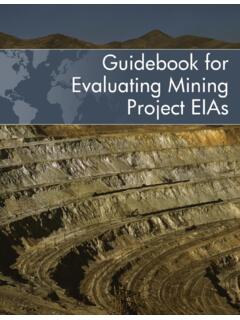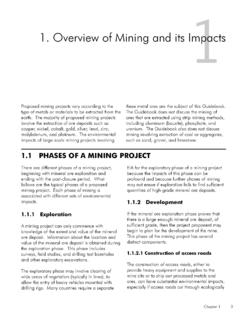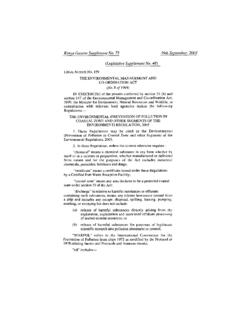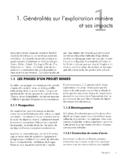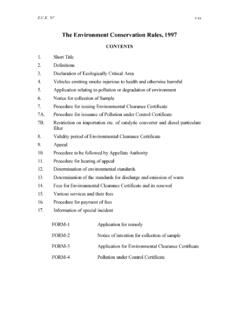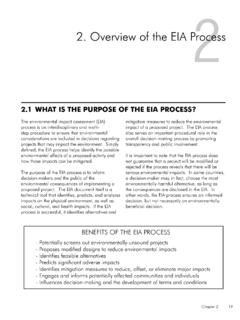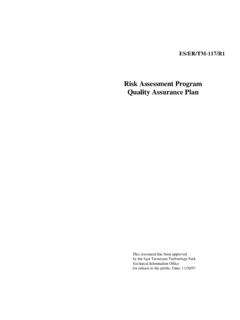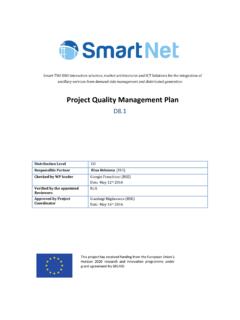Transcription of CHAPTER 6 ENVIRONMENTAL MANAGEMENT PLAN 6.1 …
1 The Tata Power Company Ltd. EIA Report for 1000 MW Coal Based Thermal Power Plant at Naraj Marthapur, Cuttack, Orissa SGS India Private Limited 134 CHAPTER 6 ENVIRONMENTAL MANAGEMENT plan Introduction ENVIRONMENTAL MANAGEMENT plan is the key to ensure that the ENVIRONMENTAL quality of the area does not deteriorate due to the operation of the plant under study. The treatment and disposal of effluents for the plant have been described in CHAPTER 2. The probable impacts have been predicted in CHAPTER 4. Present CHAPTER covers the MANAGEMENT of the overall ENVIRONMENTAL issues including the requirement of capacity building for ENVIRONMENTAL MANAGEMENT . MANAGEMENT plan consists of the following activities: i) Specific action plan for implementing mitigation measures ii) Monitoring of ENVIRONMENTAL quality iii) Rainwater Harvesting iv) Training v) Statutory requirements and Implementation vi) Documentation vii) Green Belt Plantation viii) Social Responsibility The different aspects of the ENVIRONMENTAL MANAGEMENT plan are discussed below: Implementation plan Mitigation plan is the key to ensure that the ENVIRONMENTAL qualities of the area will not deteriorate due to the construction and operation of the project .
2 The Mitigation plan covers all aspects of the construction and operation phases related to environment. The mitigation plan needs to be implemented right from the conception and should continue till the end. Implementation of ENVIRONMENTAL Mitigation Measures is the most important task of EMP. The plan can be divided into two phases - (a) During construction phase and (b) During operational phase. An The Tata Power Company Ltd. EIA Report for 1000 MW Coal Based Thermal Power Plant at Naraj Marthapur, Cuttack, Orissa SGS India Private Limited 135 implementation task list is formed and the important mitigation measures are included. The list also includes the time frame for implementation and also the responsibilities of the concerned authority. Important mitigation measures and the implementation schedule are presented in Table and Table at the end of this CHAPTER .
3 Monitoring of ENVIRONMENTAL quality The success of ENVIRONMENTAL control measure can only be understood by proper monitoring of the ENVIRONMENTAL parameters. A detailed monitoring for different ENVIRONMENTAL parameters will be carried out as per direction of Orissa Pollution Control Board. Monitoring methodologies will follow standard methods prescribed by Central Pollution Control Board (CPCB), Bureau of Indian Standards (BIS), USEPA, AWWA etc. Major monitoring parameters are discussed below. All monitoring reports will be submitted to Orissa Pollution Control Board. Ambient Air quality Ambient air quality will be monitored within the plant and in the vicinity as directed by Orissa Pollution Control Board. The parameters will include SPM, RPM, SO2 and NO2. The report will be submitted to Orissa Pollution Control Board.
4 The sampling and analysis of air pollutants will be done as per the norms suggested by Central Pollution Control Board (Emission Regulations Part-III) and also the Bureau of Indian Standards IS-5182. Stack Emissions Emission from boiler stack will be monitored monthly or as directed by West Bengal Pollution Control Board. The results will be analyzed to find out whether those are meeting the required level. PM, SO2 and NOx and gas flow will be monitored. Online automated stack monitoring equipment s will be installed for monitoring of stack emissions. The Tata Power Company Ltd. EIA Report for 1000 MW Coal Based Thermal Power Plant at Naraj Marthapur, Cuttack, Orissa SGS India Private Limited 136 Noise Monitoring Noise monitoring will be carried out inside the units near the high noise generating areas once in a month.
5 Ambient noise monitoring just outside the plant limit will be conducted monthly. Noise levels monitored will include Leq day & night, Lmax, and Lmin. Water quality Water quality at the discharge point from CMB will be monitored everyday for the relevant parameters as mentioned for Thermal Power Plants. Water quality near the discharge point on Mahanadi River will be monitored monthly. More parameters or locations may be included for monitoring if directed by Orissa Pollution Control Board. The sampling and analysis methodologies of the water samples will be as per IS-2488, IS-3025, APHA 20th Ed etc. quality assurance A quality assurance plan should be developed which will include all references methods for monitoring, relevant analytical techniques, calibration of equipment, standard of reagents, collection and presentation of results etc.
6 All monitoring activities will be reviewed to find out the implementation of all the required norms. Periodic ENVIRONMENTAL audit may be arranged to make quality assurance a success. Periodic Preventive Maintenance All pollution control, monitoring and safety equipments shall be periodically checked and calibrated. Safety & Health Periodic monitoring of the health of the workers will be carried out as required by Factories Act. For safety, mock drill of the concerned employees for handling the emergency situation will be carried out, as a part of On-Site Emergency plan . Air quality at the work place will be measured intermittently. The Tata Power Company Ltd. EIA Report for 1000 MW Coal Based Thermal Power Plant at Naraj Marthapur, Cuttack, Orissa SGS India Private Limited 137 Green Belt Development There will be all efforts for improving the ENVIRONMENTAL quality of the plant complex through tree planting in organised manner.
7 The trees will be planted inside the plant in vacant areas, along the boundary walls in rows to develop a wide green belt and also in dust- prone area Coal yard, ash pond along with vacant area for landscaping including gardening. There is about 200 acres of land with a hillock. This large tract of land will be vegetated and plantation will be developed on the hillock slope and the area will turn to be a large green park. The predominant species list for greening is as follows: Acacia auriculaeformis (akasmoni), Alstonia scholaris (chatim), Cassia fistula (bandarlathi), Lagerstroemea parviflora (jarul), Terminalia catappa (kath badam), Spathodea campanulata (spathodea), Grevellia robusta (silver oak), Delonix regia (gulmohar), Peltophorum pterocarpum (radhachura), Gmelina arberea (gamar) etc. Green belt plan is shown in the Layout plan Rainwater Harvesting Rainwater harvesting is now an important component of wise resource use and ENVIRONMENTAL MANAGEMENT .
8 During operation of the plant following approach will be taken to implement the Rainwater harvesting plan . Rainwater from the roofs of all the Station Buildings of the units, storm water drains adjoining the roads of Cooling Towers, ESP / Boiler areas of the plant shall be collected in a rainwater collection tank. All storm water drains of the main plant area shall be connected to the rainwater collection tank. Rainwater collected in the rainwater tank is to be utilised for further use. This is achieved by installing a suitable pump at one end of the tank. This shall pump the collected water to the synthetic PVC tank installed on the roof of superstructures like Station Building, etc. The size of the synthetic tank shall be suitably sized based on the rainfall intensity and the runoff there-of. Additional tanks could be installed as and when the underground tanks are added.
9 PVC pipe is proposed for pumping water from the rainwater collection tank to the tanks on top of the buildings. The Tata Power Company Ltd. EIA Report for 1000 MW Coal Based Thermal Power Plant at Naraj Marthapur, Cuttack, Orissa SGS India Private Limited 138 Collected water from the synthetic tank is distributed by gravity to desired locations for non-potable use like gardening, cleaning etc. Excess water will be discharged through CMB Training Training is of much importance in ENVIRONMENTAL MANAGEMENT . ENVIRONMENTAL science is a developing subject and the people implementing ENVIRONMENTAL strategies should remain up to date with the ENVIRONMENTAL control processes. The person in charge of the ENVIRONMENTAL jobs should attend suitable training courses. Besides, there shall be training programme for the general employees at different level.
10 Statutory Requirements and Implementation Each industry needs to meet a number of statutory requirements under Water (Prevention & Control of Pollution) Act; Air (Prevention & Control of Pollution) Act; Environment (Protection) Act; Hazardous Waste ( MANAGEMENT & Handling) Rules; Manufacture, Storage and Import of Hazardous Chemicals Rules etc. Company has also to submit yearly ENVIRONMENTAL Statements. Environment MANAGEMENT plan will ensure that these entire statutory requirements are met in time. Documentation Documentation is an important step in implementing ENVIRONMENTAL MANAGEMENT plan . All statutory norms should be kept at one place for quick references. All monitoring results should be kept at selected folders which can be easily accessed. The presentation of the results should also be planned. Graphs and diagrams can be used to show the trend in ENVIRONMENTAL quality or achievement.
